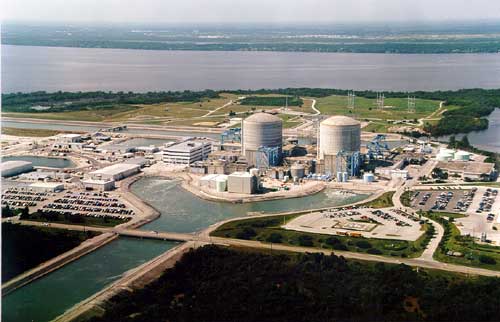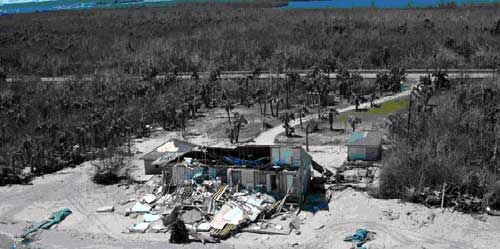 by Bob Ciminel
 Credit: "Courtesy of Florida Power & Light Company."
As with most weather-related disasters, wind does not discriminate. Almost every house I could see sustained some roof damage. Shingles are shingles, whether they are on a $100,000 house or a $600,000 house. However, West Palm Beach was not my destination; I was heading 50 miles up the coast to Ground Zero, where hurricanes Frances and Jean came ashore in September 2004. Picking up my rental car and jumping on to I-95 North, I headed for Port St. Lucie. Things looked pretty good along the Interstate; a few fences blown down; some signs missing; a couple of large trees showing their roots to the world. My hotel was in good shape, other than some peeling drywall tape in the ceiling above the window - wind-blown rain, I'm sure. Well, at least it was habitable. My hotel was about 25 miles away from the plant. All the hotels near the power plant had sustained some damage, and rooms were $200 a night. The one I was staying in was only $160 a night - quite a savings! I hadn't been in Port St. Lucie since the early Nineties when my late brother-in-law lived there, so I thought I'd better drive out to the plant to be certain I remembered how to get there. As I crossed the causeway onto Hutchinson Island, I thought I had entered a recent battlefield. Two hurricanes left the island in pretty bad shape; it was functional, but not beautiful as I remembered it. 
Hurricane Jeanne came two weeks later, arriving over Hutchinson Island at 5:30 a.m. on September 26, with 111-knot winds. This time St. Lucie power plant was south of the storm, and, again, the plant had been shut down a day earlier in anticipation of the hurricane's arrival. According to the St. Lucie County damage assessment group: "Hurricane Frances destroyed or caused major damage to 100 major structures, including 50 single-family dwellings, 21 multifamily dwellings, six commercial or other buildings, and 23 nonhabitable major structures. Hurricane Jeanne destroyed or caused major damage to 40 major structures, including four single-family dwellings, 22 multifamily dwellings, four commercial or other buildings, and 10 nonhabitable major structures. Both storms also destroyed 1,300 feet of backshore sills. Countywide, the St. Lucie County Building Department reported nearly 17,000 residences and buildings sustained damage. As for the St. Lucie nuclear plant, it was back on line the following week. There was no need to hurry; there was no place to send the power.
ciminel@sitnews.us
|